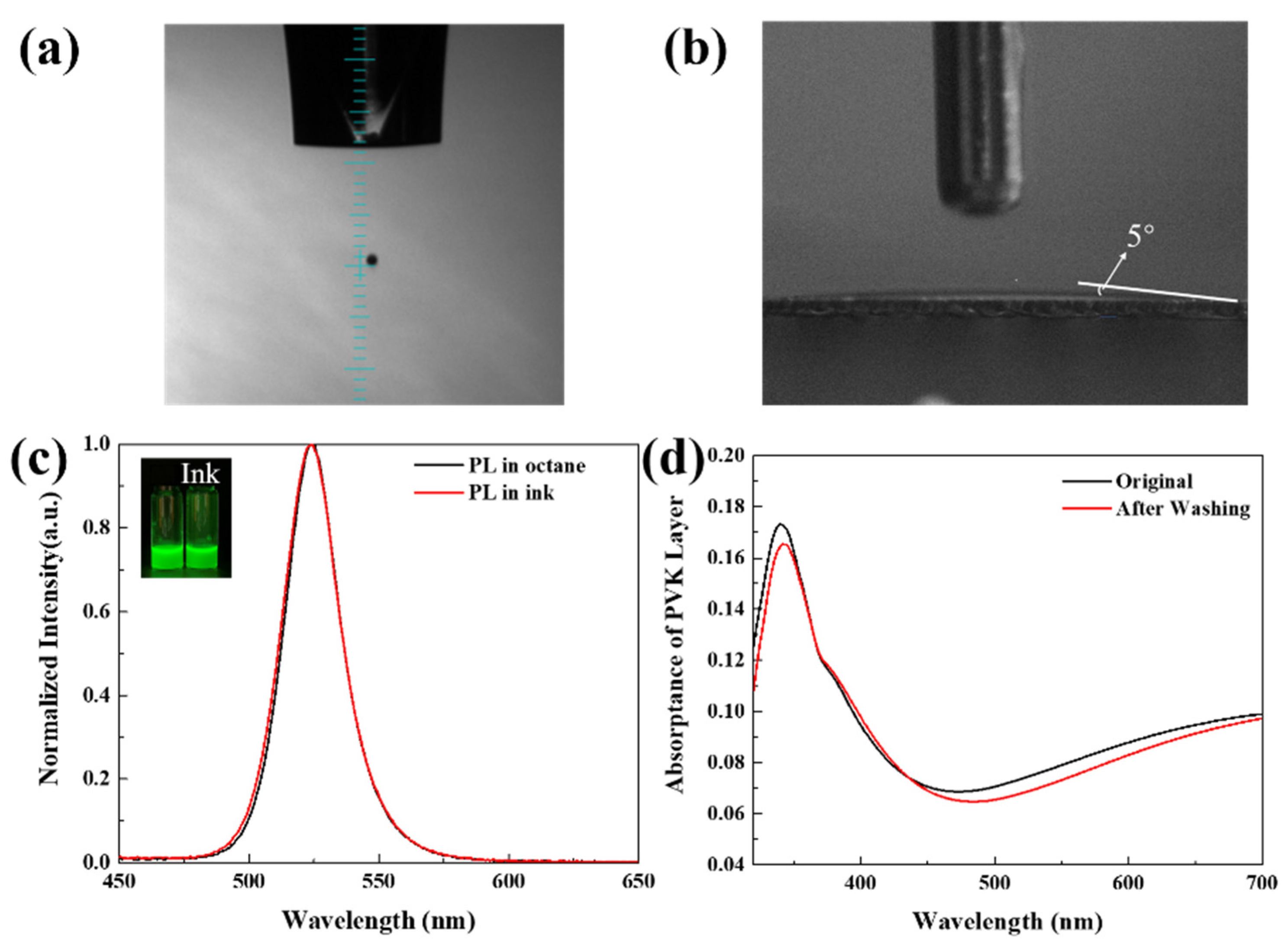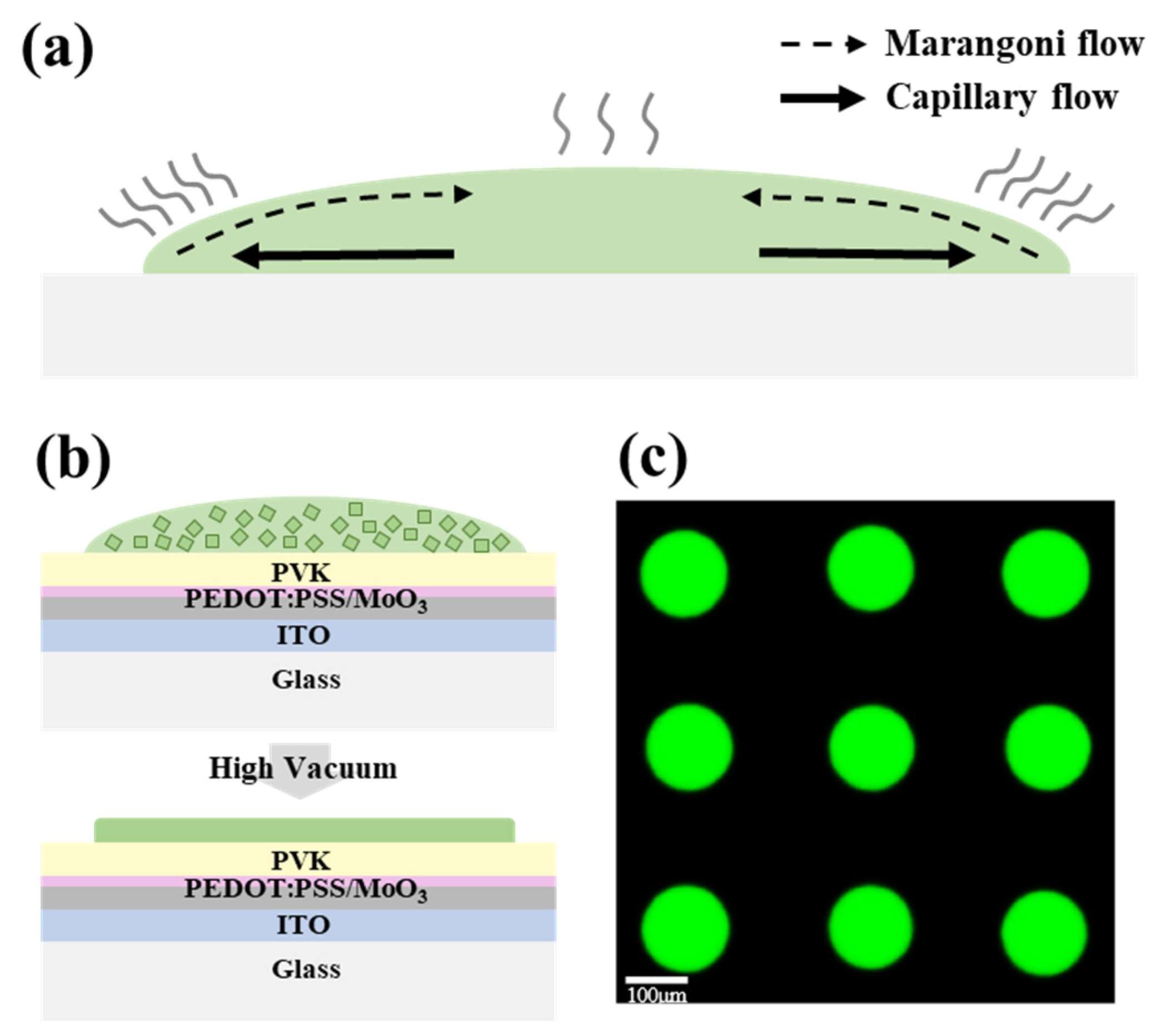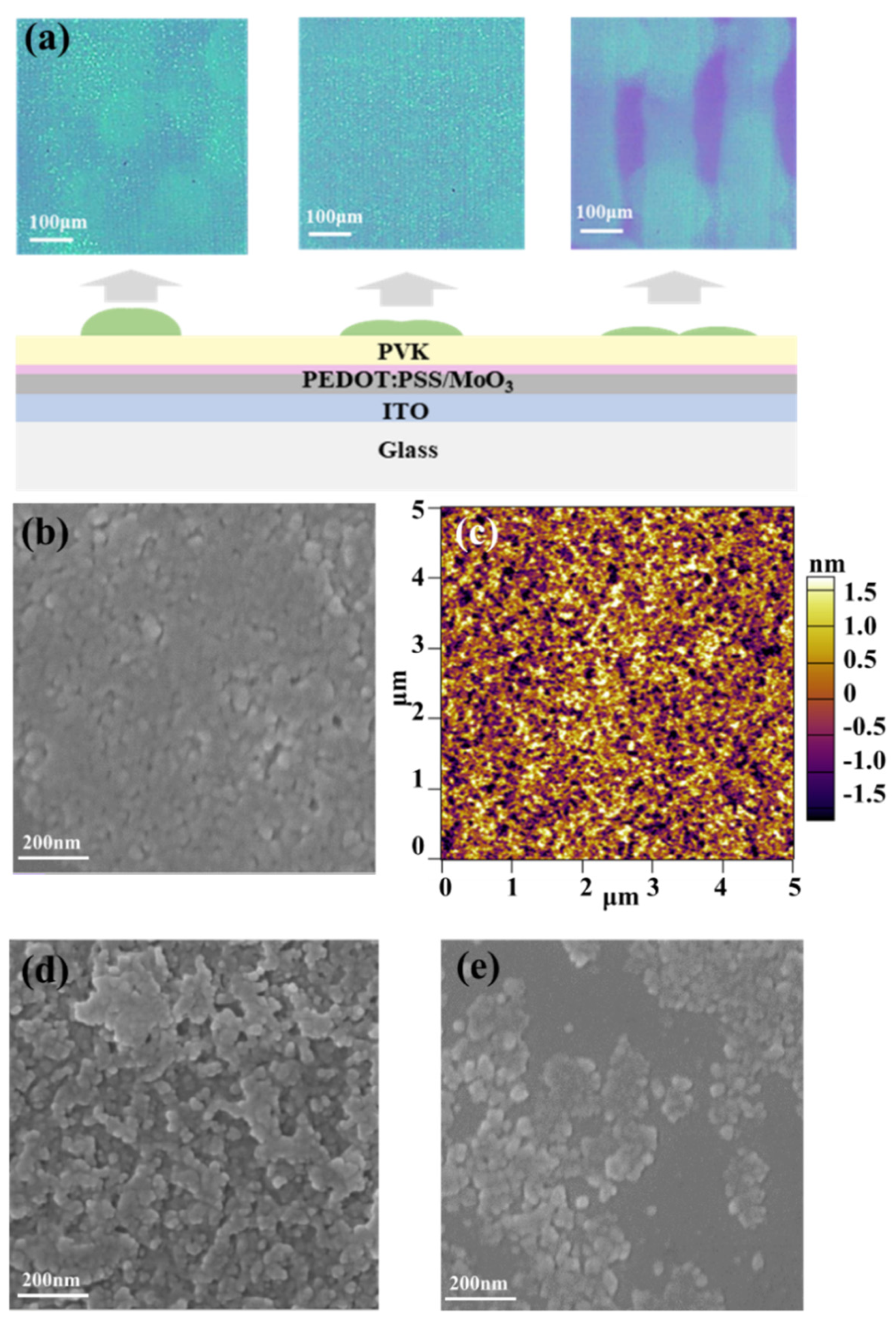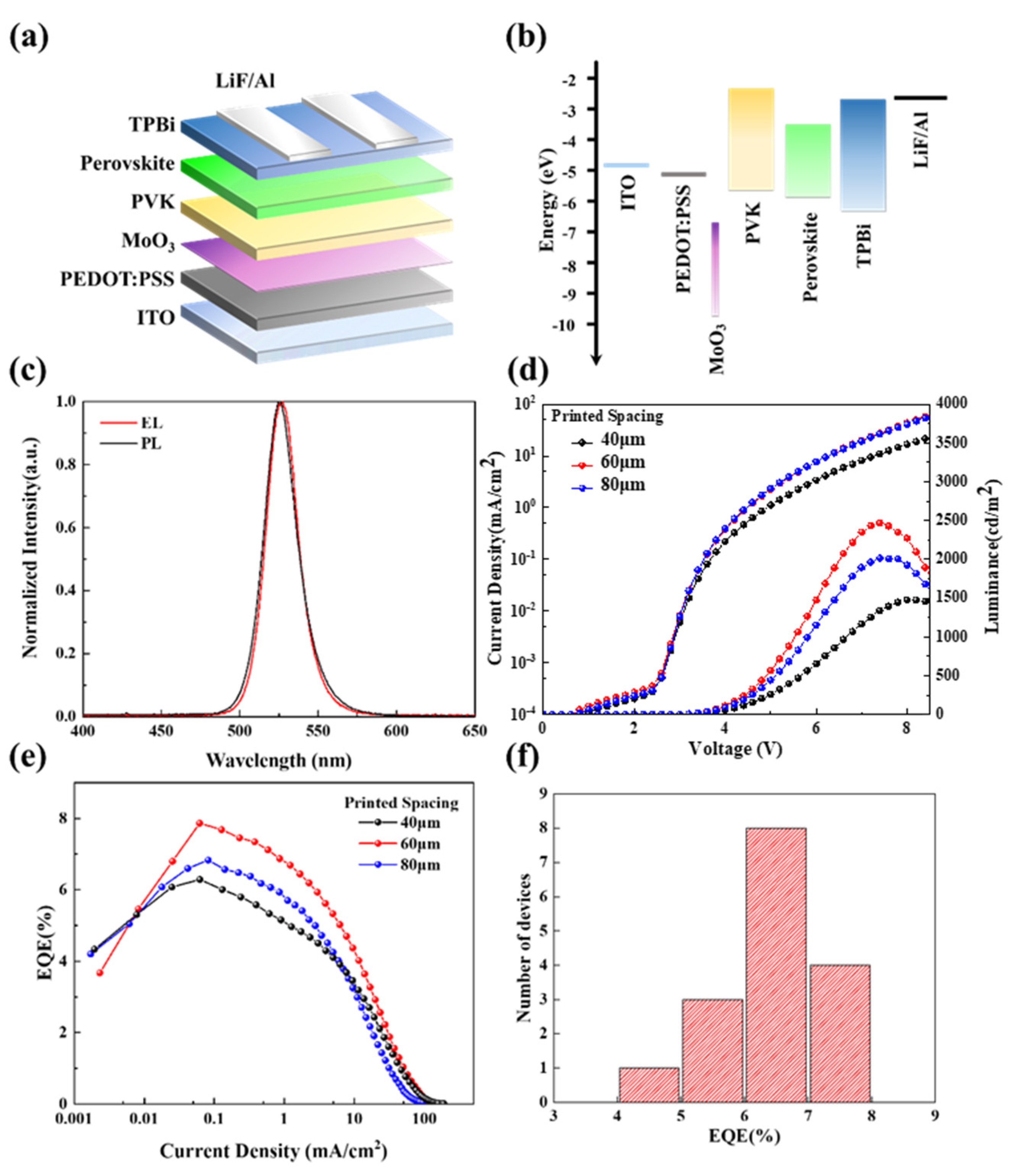Fabrication of Highly Efficient Perovskite Nanocrystal Light-Emitting Diodes via Inkjet Printing
Abstract
:1. Introduction
2. Experiments
2.1. Preparation
2.1.1. Perovskite Nanocrystal Synthesis
2.1.2. PeLED Device Fabrication
2.2. Characterization
3. Results and Discussions
4. Conclusions
Supplementary Materials
Author Contributions
Funding
Institutional Review Board Statement
Informed Consent Statement
Data Availability Statement
Conflicts of Interest
References
- Stoumpos, C.C.; Kanatzidis, M.G. Halide Perovskites: Poor Man’s High-Performance Semiconductors. Adv. Mater. 2016, 28, 5778–5793. [Google Scholar] [CrossRef] [PubMed]
- Veldhuis, S.A.; Boix, P.P.; Yantara, N.; Li, M.; Sum, T.C.; Mathews, N.; Mhaisalkar, S.G. Perovskite materials for light-emitting diodes and lasers. Adv. Mater. 2016, 28, 6804–6834. [Google Scholar] [CrossRef] [PubMed]
- Yuan, M.; Quan, L.N.; Comin, R.; Walters, G.; Sabatini, R.; Voznyy, O.; Hoogland, S.; Zhao, Y.; Beauregard, E.M.; Kanjanaboos, P.; et al. Perovskite energy funnels for efficient light-emitting diodes. Nat. Nanotechnol. 2016, 11, 872–877. [Google Scholar] [CrossRef] [PubMed]
- Wu, Y.; Li, X.; Zeng, H. Highly Luminescent and Stable Halide Perovskite Nanocrystals. ACS Energy Lett. 2019, 4, 673–681. [Google Scholar]
- Cai, J.; Wang, C.; Hu, X.; Ye, Y.; Zhong, L.; Chen, E.; Ye, Y.; Xu, S.; Sun, J.; Yan, Q.; et al. Water-driven photoluminescence reversibility in CsPbBr3/PDMS-PUa composite. Nano Res. 2022. [Google Scholar] [CrossRef]
- Wang, C.; Cai, J.; Ye, Y.; Hu, X.; Zhong, L.; Xie, H.; Chen, E.; Ye, Y.; Xu, S.; Sun, J.; et al. Full-visible-spectrum perovskite quantum dots by anion exchange resin assisted synthesis. Nanophotonics 2022, 11, 1355–1366. [Google Scholar] [CrossRef]
- Hua, Y.; Wei, Y.; Chen, B.; Liu, Z.; He, Z.; Xing, Z.; Liu, S.; Huang, P.; Chen, Y.; Gao, Y.; et al. Directional and fast photoluminescence from CsPbI3 nanocrystals coupled to dielectric circular Bragg gratings. Micromachines 2021, 12, 422. [Google Scholar] [CrossRef]
- Wang, H.; Kosasih, F.U.; Yu, H.; Zheng, G.; Zhang, J.; Pozina, G.; Liu, Y.; Bao, C.; Hu, Z.; Liu, X.; et al. Perovskite-molecule composite thin films for efficient and stable light-emitting diodes. Nat. Commun. 2020, 11, 891. [Google Scholar] [CrossRef] [Green Version]
- Zhang, X.; Xu, B.; Zhang, J.; Gao, Y.; Zheng, Y.; Wang, K.; Sun, X.W. All-inorganic perovskite nanocrystals for high-efficiency light emitting diodes: Dual-phase CsPbBr3-CsPb2Br5 composites. Adv. Funct. Mater. 2016, 26, 4595–4600. [Google Scholar] [CrossRef]
- Zhang, X.; Liu, H.; Wang, W.; Zhang, J.; Xu, B.; Karen, K.L.; Zheng, Y.; Liu, S.; Chen, S.; Wang, K.; et al. Hybrid perovskite light-emitting diodes based on perovskite nanocrystals with organic-inorganic mixed cations. Adv. Mater. 2017, 29, 1606405. [Google Scholar] [CrossRef]
- Lin, K.; Xing, J.; Quan, L.N.; de Arquer, F.P.G.; Gong, X.; Lu, J.; Xie, L.; Zhao, W.; Zhang, D.; Yan, C.; et al. Perovskite light-emitting diodes with external quantum efficiency exceeding 20 per cent. Nature 2018, 562, 245–248. [Google Scholar] [CrossRef]
- Wang, Q.; Wang, X.; Yang, Z.; Zhou, N.; Deng, Y.; Zhao, J.; Xiao, X.; Rudd, P.; Moran, A.; Yan, Y.; et al. Efficient sky-blue perovskite light-emitting diodes via photoluminescence enhancement. Nat. Commun. 2019, 10, 5633. [Google Scholar] [CrossRef] [PubMed] [Green Version]
- Schulz, P.; Cahen, D.; Kahn, A. Halide Perovskites: Is it all about the interfaces? Chem. Rev. 2019, 119, 3349–3417. [Google Scholar] [CrossRef] [PubMed] [Green Version]
- Li, J.; Hu, M.; Wang, Z.; Lu, Y.; Wang, K.; Zhu, X. The scaling of the ligand concentration and Soret effect induced phase transition in CsPbBr3 perovskite quantum dots. J. Mater. Chem. A 2019, 7, 27241–27246. [Google Scholar] [CrossRef]
- Giuri, A.; Saleh, E.; Listorti, A.; Colella, S.; Rizzo, A.; Tuck, C.; Esposito Corcione, C. Rheological tunability of perovskite precursor solutions: From spin coating to inkjet printing process. Nanomaterials 2019, 9, 582. [Google Scholar] [CrossRef] [PubMed] [Green Version]
- Singh, M.; Haverinen, H.M.; Dhagat, P.; Jabbour, G.E. Inkjet printing-process and its applications. Adv. Mater. 2010, 22, 673–685. [Google Scholar] [CrossRef]
- Liu, Y.; Li, F.; Xu, Z.; Zheng, C.; Guo, T.; Xie, X.; Qian, L.; Fu, D.; Yan, X. Efficient all-solution processed quantum dot light emitting diodes based on inkjet printing technique. ACS Appl. Mater. Interfaces 2017, 9, 25506–25512. [Google Scholar] [CrossRef]
- Xiang, C.; Wu, L.; Lu, Z.; Li, M.; Wen, Y.; Yang, Y.; Liu, W.; Zhang, T.; Cao, W.; Tsang, S.W.; et al. High efficiency and stability of ink-jet printed quantum dot light emitting diodes. Nat. Commun. 2020, 11, 1646. [Google Scholar] [CrossRef] [Green Version]
- Kordas, K.; Mustonen, T.; Toth, G.; Jantunen, H.; Lajunen, M.; Soldano, C.; Talapatra, S.; Kar, S.; Vajtai, R.; Ajayan, P.M. Inkjet printing of electrically conductive patterns of carbon nanotubes. Small 2006, 2, 1021–1025. [Google Scholar] [CrossRef]
- Tortorich, R.P.; Choi, J.W. Inkjet printing of carbon nanotubes. Nanomaterials 2013, 3, 453–468. [Google Scholar] [CrossRef] [Green Version]
- Ko, S.H.; Pan, H.; Grigoropoulos, C.P.; Luscombe, C.K.; Fréchet, J.M.J.; Poulikakos, D. All-inkjet-printed flexible electronics fabrication on a polymer substrate by low-temperature high-resolution selective laser sintering of metal nanoparticles. Nanotechnology 2007, 18, 345202. [Google Scholar] [CrossRef]
- Grouchko, M.; Kamyshny, A.; Magdassi, S. Formation of air-stable copper–silver core–shell nanoparticles for inkjet printing. J. Mater. Chem. 2009, 19, 3057–3062. [Google Scholar] [CrossRef]
- Lan, L.; Zou, J.; Jiang, C.; Liu, B.; Wang, L.; Peng, J. Inkjet printing for electroluminescent devices: Emissive materials, film formation, and display prototypes. Front. Optoelectron. 2017, 10, 329–352. [Google Scholar] [CrossRef]
- Mathies, F.; List-Kratochvil, E.J.W.; Unger, E.L. Advances in inkjet-printed metal halide perovskite photovoltaic and optoelectronic devices. Energy Technol. 2020, 8, 1900991. [Google Scholar] [CrossRef] [Green Version]
- Shi, L.; Meng, L.; Jiang, F.; Ge, Y.; Li, F.; Wu, X.-g.; Zhong, H. In situ inkjet printing strategy for fabricating perovskite quantum dot patterns. Adv. Funct. Mater. 2019, 29, 1903648. [Google Scholar] [CrossRef]
- Choi, S.; Lee, S.Y.; Kim, D.Y.; Park, H.-K.; Ko, M.J.; Cho, K.H.; Choi, J. The synthesis and characterisation of the highly stable perovskite nano crystals and their application to ink-jet printed colour conversion layers. J. Ind. Eng. Chem. 2020, 85, 226–239. [Google Scholar] [CrossRef]
- Jia, S.; Li, G.; Liu, P.; Cai, R.; Tang, H.; Xu, B.; Wang, Z.; Wu, Z.; Wang, K.; Sun, X.W. Highly luminescent and stable green quasi-2D perovskite-embedded polymer sheets by inkjet printing. Adv. Funct. Mater. 2020, 24, 1910817. [Google Scholar] [CrossRef]
- Li, D.; Wang, J.; Li, M.; Xie, G.; Guo, B.; Mu, L.; Li, H.; Wang, J.; Yip, H.L.; Peng, J. Inkjet printing matrix perovskite quantum dot light-emitting devices. Adv. Mater. Technol. 2020, 5, 2000099. [Google Scholar] [CrossRef]
- Hermerschmidt, F.; Mathies, F.; Schröder, V.R.F.; Rehermann, C.; Morales, N.Z.; Unger, E.L.; List-Kratochvil, E.J.W. Finally, inkjet-printed metal halide perovskite LEDs—Utilizing seed crystal templating of salty PEDOT:PSS. Mater. Horiz. 2020, 7, 1773–1781. [Google Scholar] [CrossRef]
- Li, Y.; Chen, Z.; Liang, D.; Zang, J.; Song, Z.; Cai, L.; Zou, Y.; Wang, X.; Wang, Y.; Li, P.; et al. Coffee-stain-free perovskite film for efficient printed light-emitting diode. Adv. Opt. Mater. 2021, 9, 2100553. [Google Scholar] [CrossRef]
- Gao, A.; Yan, J.; Wang, Z.; Liu, P.; Wu, D.; Tang, X.; Fang, F.; Ding, S.; Li, X.; Sun, J.; et al. Printable CsPbBr3 perovskite quantum dot ink for coffee ring-free fluorescent microarrays using inkjet printing. Nanoscale 2020, 12, 2569–2577. [Google Scholar] [CrossRef]
- Cai, R.; Qu, X.; Liu, H.; Yang, H.; Wang, K.; Sun, X.W. Perovskite light-emitting diodes based on FAPb1−xSnxBr3 nanocrystals synthesized at room temperature. IEEE Trans. Nanotechnol. 2019, 18, 1050–1056. [Google Scholar] [CrossRef]
- Zou, Y.; Ban, M.; Cui, W.; Huang, Q.; Wu, C.; Liu, J.; Wu, H.; Song, T.; Sun, B. A general solvent selection strategy for solution processed quantum dots targeting high performance light-emitting diode. Adv. Funct. Mater. 2017, 27, 1603325. [Google Scholar] [CrossRef]
- Park, Y.; Park, Y.; Lee, J.; Lee, C. Simulation for forming uniform inkjet-printed quantum dot layer. J. Appl. Phys. 2019, 125, 065304. [Google Scholar] [CrossRef]
- Agble, D.; Mendes-Tatsis, M.A. The prediction of Marangoni convection in binary liquid-liquid systems with added surfactants. Int. J. Heat Mass Transf. 2001, 44, 1439–1449. [Google Scholar] [CrossRef]
- Xiao, X.; Wang, K.; Ye, T.; Cai, R.; Ren, Z.; Wu, D.; Qu, X.; Sun, J.; Ding, S.; Sun, X.W.; et al. Enhanced hole injection assisted by electric dipoles for efficient perovskite light-emitting diodes. Commun. Mater. 2020, 1, 81. [Google Scholar] [CrossRef]
- Zheng, X.; Hou, Y.; Sun, H.T.; Mohammed, O.F.; Sargent, E.H.; Bakr, O.M. Reducing defects in halide perovskite nanocrystals for light-emitting applications. J. Phys. Chem. Lett. 2019, 10, 2629–2640. [Google Scholar] [CrossRef] [Green Version]
- Zheng, C.; Zheng, X.; Feng, C.; Ju, S.; Xu, Z.; Ye, Y.; Guo, T.; Li, F. High-brightness perovskite quantum dot light-emitting devices using inkjet printing. Org. Electron. 2021, 93, 106168. [Google Scholar] [CrossRef]




| Type of Solution | Molecular Weight | Boiling Point (°C) | Vapor Pressure (mmHg at 25 °C) | Viscosity (mPa·s at 25 °C) | Surface Tension (mN/m) |
|---|---|---|---|---|---|
| Octane | 114.23 | 125 | 14.1 | 0.51 | 21.14 |
| Dodecane | 170.33 | 216 | 0.135 | 1.48 | 25.44 |
| Mixed Ink | / | / | / | 1.25 | 23.3 |
| Steps (μm) | RMS Roughness (nm) | Thickness (nm) |
|---|---|---|
| 20 | 4.9 | 34.92 |
| 40 | 1.8 | 26.07 |
| 60 | 0.7 | 23.84 |
| 80 | 0.9 | 18.59 |
| Steps (μm) | Turn-On Voltage (V) | Max. Current Efficiency (cd/A) | Max. EQE (%) | Max. Luminance (cd/m2) |
|---|---|---|---|---|
| 20 | / | / | / | / |
| 40 | 3.0 | 24.7 | 6.2 | 1476 |
| 60 | 3.0 | 32.0 | 7.9 | 2465 |
| 80 | 3.0 | 26.8 | 6.8 | 2017 |
| Year | Emission Layer | Max. Luminance (cd/m2) | Max. Current Efficiency (cd/A) | Max. EQE (%) | Ref. |
|---|---|---|---|---|---|
| 2020 | FA0.3Cs0.7PbBr3 quantum dots | 1233 | 10.3 | 2.8 | [28] |
| 2020 | MAPbBr3 | 4000 | <0.9 | / | [29] |
| 2021 | CsPbBr3 quantum dots | 10,992 | 8.67 | 3.03 | [38] |
| 2021 | PEA2Csn−1PbnBr3n+1 quasi-2D | 3640 | 31.5 | 9.0 | [30] |
| This work | FAPb0.7Sn0.3Br3 nanocrystals | 2465 | 32.0 | 7.9 | / |
Publisher’s Note: MDPI stays neutral with regard to jurisdictional claims in published maps and institutional affiliations. |
© 2022 by the authors. Licensee MDPI, Basel, Switzerland. This article is an open access article distributed under the terms and conditions of the Creative Commons Attribution (CC BY) license (https://creativecommons.org/licenses/by/4.0/).
Share and Cite
Ye, T.; Jia, S.; Wang, Z.; Cai, R.; Yang, H.; Zhao, F.; Tan, Y.; Sun, X.; Wu, D.; Wang, K. Fabrication of Highly Efficient Perovskite Nanocrystal Light-Emitting Diodes via Inkjet Printing. Micromachines 2022, 13, 983. https://doi.org/10.3390/mi13070983
Ye T, Jia S, Wang Z, Cai R, Yang H, Zhao F, Tan Y, Sun X, Wu D, Wang K. Fabrication of Highly Efficient Perovskite Nanocrystal Light-Emitting Diodes via Inkjet Printing. Micromachines. 2022; 13(7):983. https://doi.org/10.3390/mi13070983
Chicago/Turabian StyleYe, Taikang, Siqi Jia, Zhaojin Wang, Rui Cai, Hongcheng Yang, Fangqing Zhao, Yangzhi Tan, Xiaowei Sun, Dan Wu, and Kai Wang. 2022. "Fabrication of Highly Efficient Perovskite Nanocrystal Light-Emitting Diodes via Inkjet Printing" Micromachines 13, no. 7: 983. https://doi.org/10.3390/mi13070983
APA StyleYe, T., Jia, S., Wang, Z., Cai, R., Yang, H., Zhao, F., Tan, Y., Sun, X., Wu, D., & Wang, K. (2022). Fabrication of Highly Efficient Perovskite Nanocrystal Light-Emitting Diodes via Inkjet Printing. Micromachines, 13(7), 983. https://doi.org/10.3390/mi13070983







